Core i9-12900HK review: Intel 'Alder Lake' laptops crush the competition

 Image: Intel
Image: IntelIntel must be fans of Netflix’s Cobra Kai because it’s taken the mantra of “strike hard, strike first” to heart with its 12th-gen “Alder Lake H” laptop CPUs. And yes, there’s no mercy either, because the 12th-gen Core i9-12900HK leaves the floor covered with the bodies of both its direct predecessor and AMD’s rival Ryzen 9.
If this is a little too 1980s throwback for you, then maybe the simple math of “14 is more than 8” is more meaningful. As in, 14-cores in a Core i9-12900HK is simply almost always going to be more than the 8-cores in an 11th gen Core i9-11980HK or the 8-cores in a Ryzen 9 5900HX, even with Intel’s new chips using a mixture of high-performance and high-efficiency cores.
To see just how much 14 is more than 8, you’ll have to read on. But the bottom line? The Core i9-12900HK sets a new standard for high-performance laptops, whether you’re gaming or getting work done. After debuting in knock-out fashion on desktops, Intel’s Alder Lake simply crushes the competition—and its predecessor—in notebooks.
Intel’s Core i9-12900HK is the new high-performance laptop champion, and it’s not even close.
How we tested
For this review, no thin and light laptops were allowed, and we solely focused on the platforms that are best paired with Intel and AMD’s most powerful CPUs. In other words, big beefy 17.3-inch gaming laptops paired with big beefy power bricks.
Asus ROG Strix SCAR G17 with an 8-core AMD Ryzen 9 5900HX, Nvidia GeForce RTX 3080 Laptop GPU with 130 watt TGP, 32GB of DDR4/3200 and a 2TB PCIe 3.0 NVMe SSD. The laptop’s screen is a 1080p panel with a 360Hz refresh rate.MSI GE76 Raider with an 11th-gen Intel 8-core Core i9-11980HK and GeForce RTX 3080 Laptop GPU with 165 watt TGP, 32GB of DDR4/3200 and a 1TB NVMe PCIe 4.0 SSD. The laptop’s screen is a 1080p panel with a 360Hz refresh rate.MSI GE76 Raider with a 12th-gen Intel 14-core Core i9-12900HK and GeForce RTX 3080 Ti Laptop GPU with 175 watt TGP, 32GB of DDR5/4800 and two 2TB NVMe PCIe 4.0 SSDs. The laptop’s screen is a 1080p panel with a 360Hz refresh rate.
The latest version of Windows 11 was in place on all three laptops along with nearly the same GPU drivers. For the 11th-gen Intel and Ryzen 5000 laptops, we used Nvidia’s Game Ready 511.23 drivers, while the newest drivers we could access that supported the faster GeForce RTX 3080 Ti Laptop was the 511.14 driver. For OS testing, we opted to run with the default of Hardware-accelerated GPU scheduling enabled, but we opted to leave Virtual Based Security off on all three laptops. Nvidia’s performance-boosting PCIe Resizable BAR technology was enabled on all these laptops, too.
AMD’s Ryzen 9 5900HX isn’t the company’s fastest Ryzen 9 chip, but it’s pretty close and acts as a good stand in. The fastest is the Ryzen 9 5980HX, which has the same core count and TDP+ options, but clocks in at 200MHz higher than the Ryzen 9 5900HX’s boost clock of 4.6GHz.
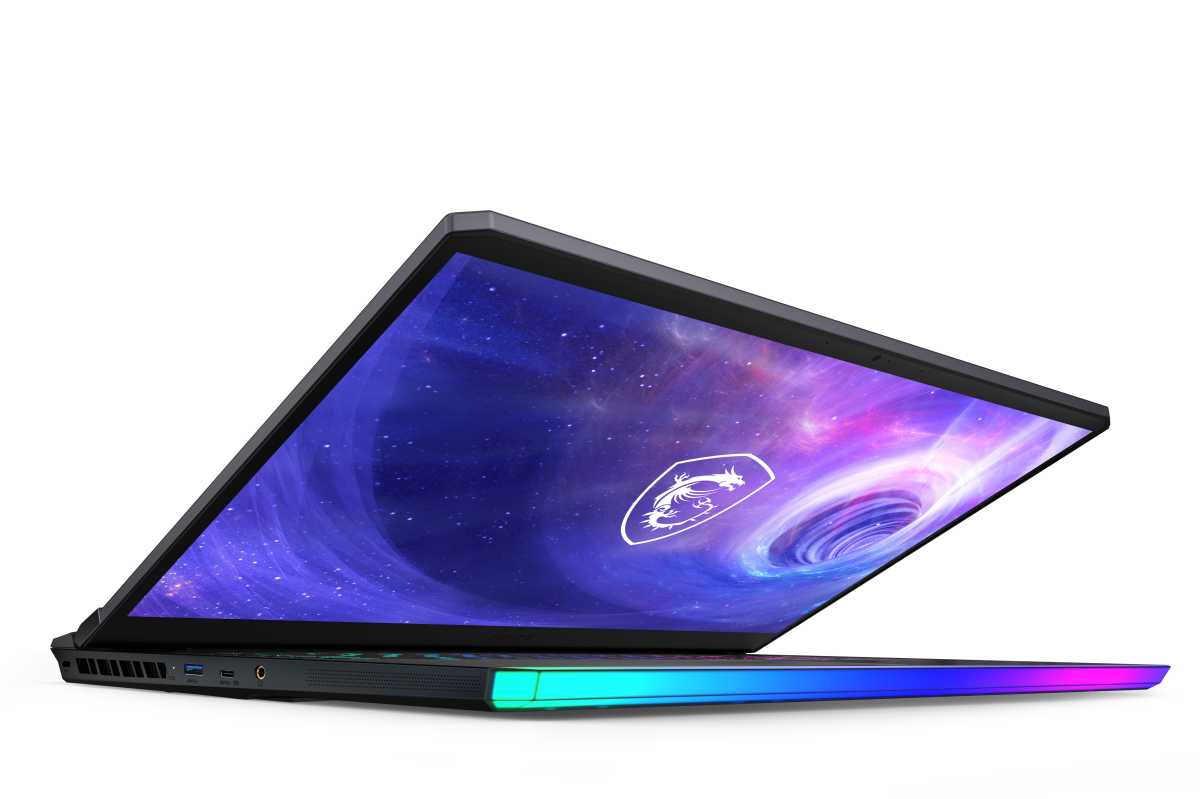
MSI
MSI
MSI
GeForce RTX 3080 Ti vs GeForce RTX 3080
Although we have three GeForce GPUs in these laptops, they’re clearly different. Both the Asus and 11th-gen GE76 use GeForce RTX 3080 Laptop GPUs with the same memory bus, the same amount of memory, and the same amount of CUDA cores, Tensor cores, and ray tracing cores.
The key difference between those GPUs is the maximum wattage. The Ryzen laptop can draw 130 watts with Dynamic Boost 2.0 enabled, while the 11th-gen Raider pulls down 165 watts with DB2.0 active. That’s about 27 percent higher potential wattage between the two. In clock speeds, the higher wattage RTX 3080 can hit 1,710MHz with the RAM clocked at 1,750MHz. The 130 watt RTX 3080 in the Asus can boost to 1,645MHz and, with its RAM clocked a little faster at 1,788MHz, it actually has slightly more memory bandwidth than the hotter one in the 11th-gen frame.
Both those GPUs don’t hold a candle to the newer GeForce RTX 3080 Ti Laptop GPU, though, which Nvidia said is aimed at 1440p gaming at 120 FPS+.
The GeForce RTX 3080 Ti Laptop GPU essentially bumps up core counts 21 percent across the board. It has 7,424 CUDA cores vs. the non-TI’s 6,144 as well as 232 Tensor cores vs the plain GPU’s 192. You also get a bonus in ray tracing cores, which goes from the standard 3080’s 48 up to 58 in the RTX 3080 Ti. Clock speeds, however, actually fall somewhat, with the maximum boost clock hitting 1,590MHz for the RTX 3080 Ti versus the plain 3080’s 1,710 boost clock. The GeForce RTX 3080 Ti Laptop GPU also ups RAM to 2,000MHz, which gives it a nice 512GBps of memory bandwidth versus the 448GBps of the GPU in the 11th-gen GE76 notebook, and 458GBps for the GPU in Asus’s Ryzen laptop.
3D rendering performance
We’ll kick this off where we usually do: Maxon’s Cinebench R23. This is a popular 3D modelling benchmark based on the company’s rendering engine, sold in its Cinema4D application. It’s sold as a stand-alone app and also integrated into Adobe After Effects.
Like most 3D modelling, Cinebench simply loves CPU cores and threads. The default benchmark runs about 10 minutes and is intended as mild stress test. CPU’s that rely on short-term boost clocks tend to shed performance more than ones that can run cooler or are kept cooler.
The results in a multi-threaded test shouldn’t surprise anyone as we see the 14-core Core i9-12900HK outpace the 8-core Ryzen 9 5900HX by almost 17 percent. Considering how shockingly fast the Ryzen 9 5900HX felt last year, that says a lot. The 8-core 11th-gen Core i9-11980HK is burned even more, with the 12th-gen chip outpacing it by 27 percent in Cinebench R23. Remember folks, Intel’s Alder Lake H mixes performance cores with efficiency cores. In this case, its six performance cores and eight efficiency cores adds up to what we expect to be leadership performance in all things multi-threaded.

IDG
IDG
IDG
The world doesn’t really run on multi-threaded performance, though. Yes, we all wish it did so we could justify having a 16-core or 32-core CPU, but you’re more likely to run applications that only use a single CPU core.
To get a feel for how the Core i9-12900HK handles that task, we run Cinebench R23 using a single-threaded load. Its performance against Ryzen 9 is even more impressive as we see the performance gap open up to nearly 27 percent for the 12th-gen Core i9. Intel’s previous 11th-gen chip was no slouch in single-threaded performance, though, as it also outperforms Ryzen 9. Still, the newest performance cores in the Core i9-12900HK outpace the 11th-gen Core i9 by a very respectable 17 percent.
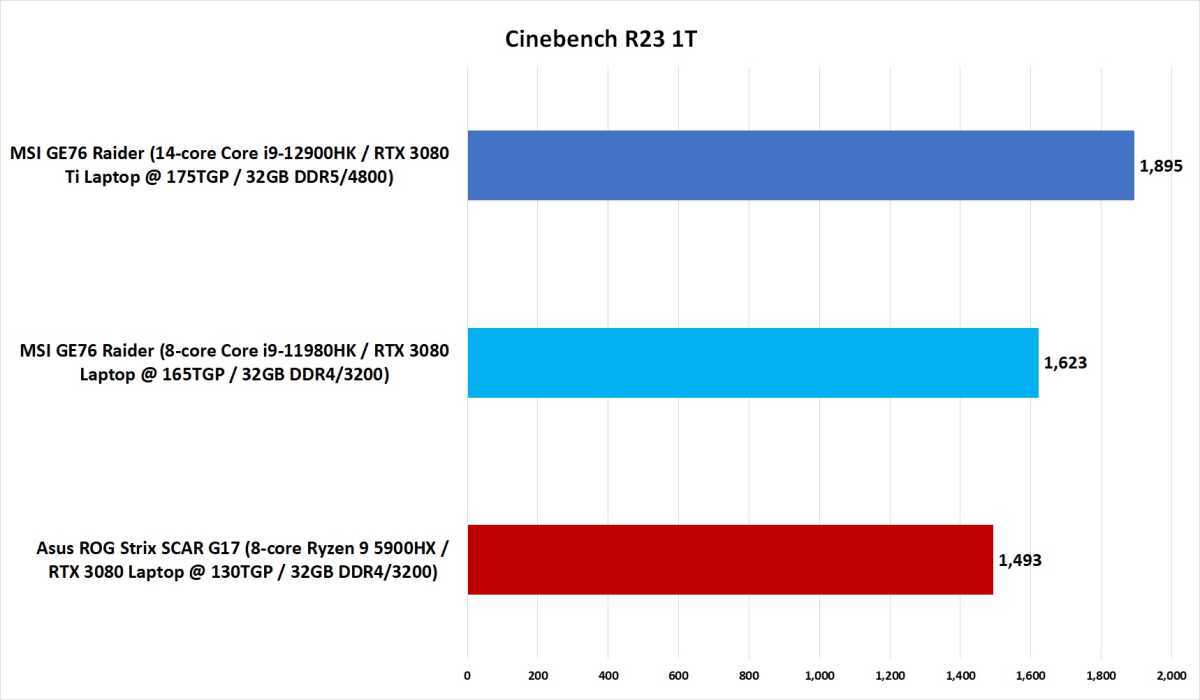
IDG
IDG
IDG
Up next is Chaos Group’s V-Ray 5 benchmark, which is notable for receiving an Academy Award. More importantly, V-Ray contributes to the Marvel Cinematic Universe and has seen service in Dr. Strange and Deadpool (yeah, we know that’s Fox, but it’s part of the MCU now folks.)
The benchmark lets you measure CPU performance as well as the GPU’s CUDA and RTX performance. On the CPU side, we see the new Alder Lake H laptop sprint past the Ryzen 9 to the tune of 23 percent. Against its winded 11th gen sibling, it cruises to a 30 percent advantage.
On the GPU front, the 175 Watt TGP GeForce RTX 3080 Ti Laptop chip outpaces the 165 watt TGP GeForce RTX 3089 Laptop by a respectible 9 percent in CUDA performance and 7.6 percent in RTX performance.
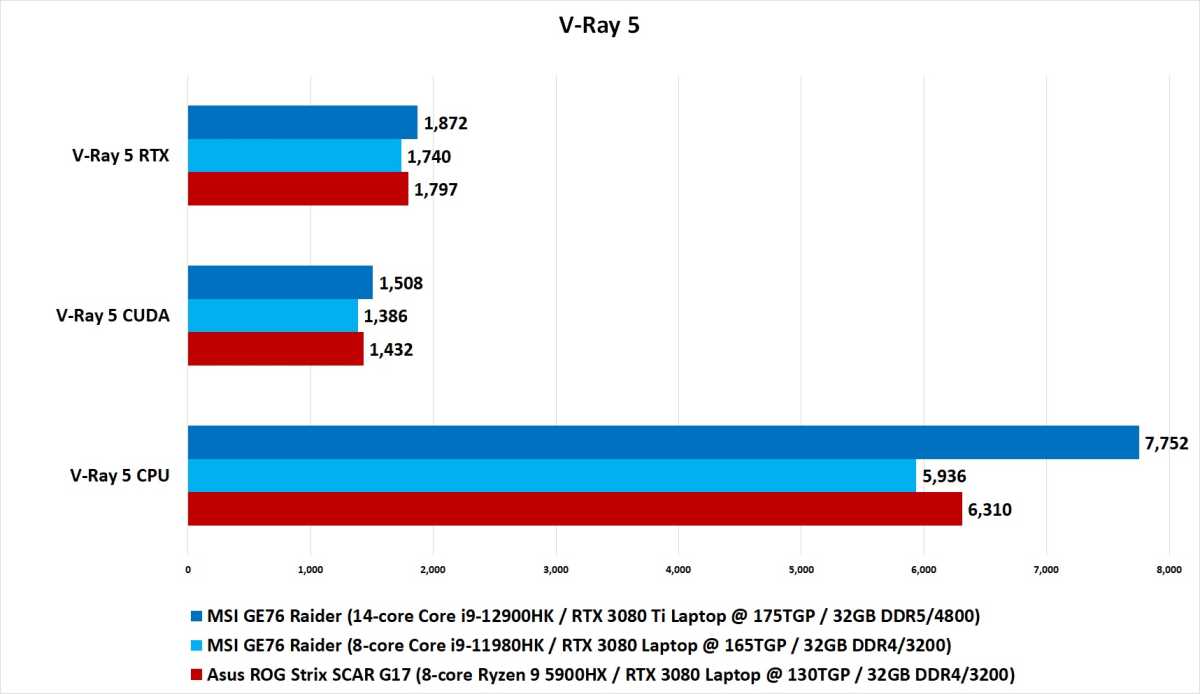
IDG
IDG
IDG
Up next is the open-source Blender 3.0 rendering and modelling application. It’s popular in the indie movie front because of its price, but it’s also pretty good. We measure the CPU performance by using the Barbershop Interior benchmark scene and the Cycles renderer. On desktops, the 16-core Ryzen 9 5950X actually outpaces the 16-core Core i9-12900K thanks to it packing 16 high performance cores versus the Alder Lake’s eight performance cores and eight efficiency cores. On the laptop though, it’s not quite a fair fight, as we again see the value of the six performance cores and eight efficiency cores giving the new Intel Core i9 a 9.8 percent bump over the Ryzen 9. It’s even larger against the 8-core 11th-gen chip, with an advantage of 23 percent for the newer Intel CPU.
We could continue to run more multi-threaded modelling benchmarks, which might see the 11th gen and Ryzen 9 get closer—or further away—but we think most would agree it’s going to be hard for 8-cores to beat 14-cores so let’s just move on. The Core i9-12900HK doesn’t need to show off anymore here.
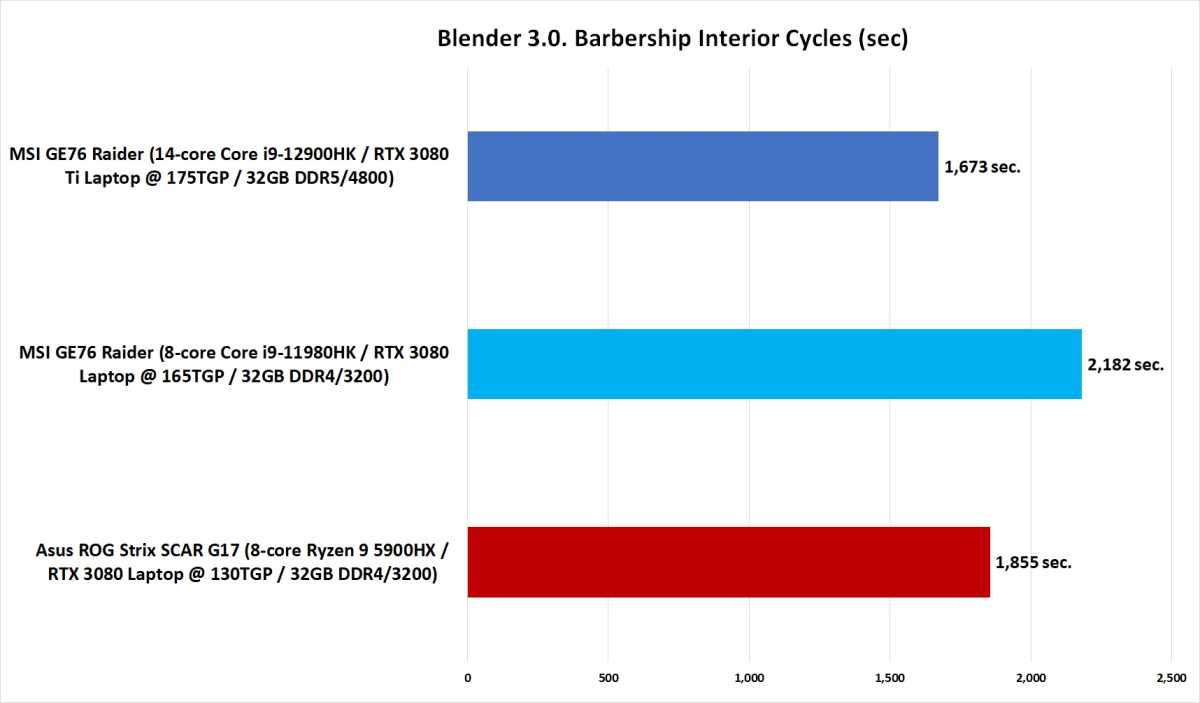
IDG
IDG
IDG
AI performance
Our next test uses Nero’s free Score benchmark that looks at both AI performance as well as H.264 encode and decode performance. The AI is built around Intel’s OpenVINO platform, so it’s a home field advantage. That gives the Core i9-12900HK a massive 39 percent advantage against the Ryzen 9. Intel’s 11th-gen Core i9 fairs far better, only falling behind the new chip by 7 percent. Why so close? As we said, it’s a home field advantage for newer Intel CPUs in AI performance built around OpenVINO. AMD fans may boo the results but Intel’s massive investment in AI acceleration is starting to pay off. The huge H.264 encode and decode win, however, isn’t about OpenVINO performance, but likely the core-count advantage for the 12th-gen Alder Lake H CPU. That results in a massive 43 percent advantage over the Ryzen 9 and 39 percent over the 11th-gen Core i9.
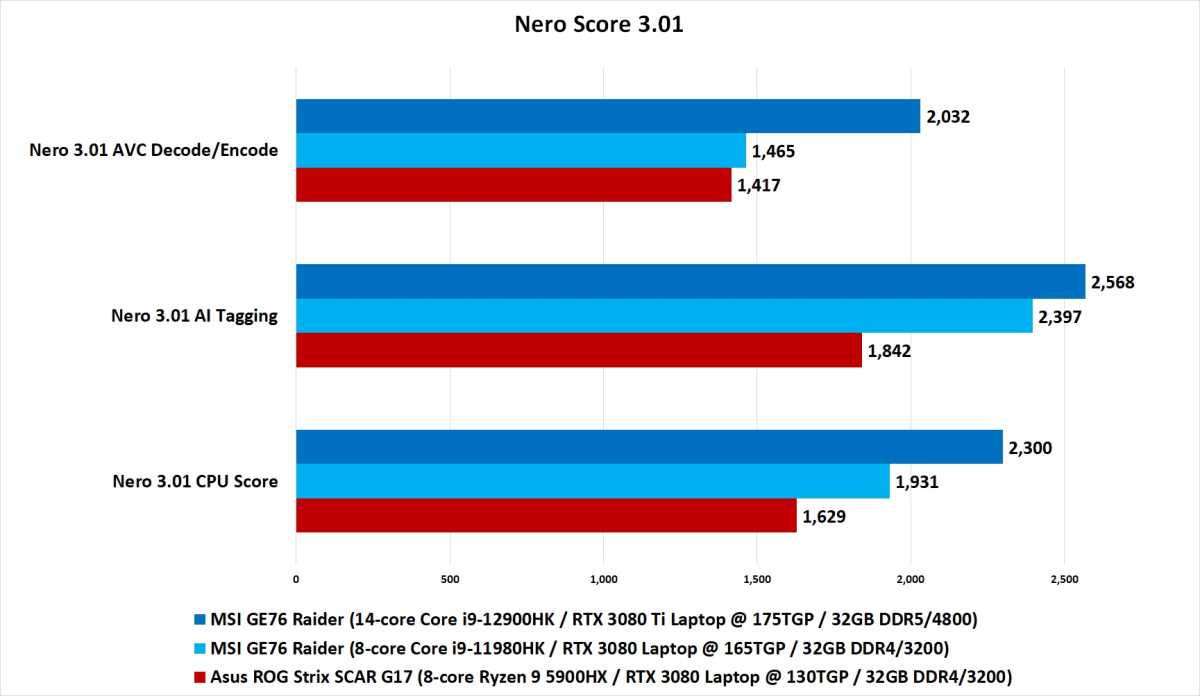
IDG
IDG
IDG
Content creation performance
3D modelling and AI is important, but likely a tiny sliver compared to what most people do in content creation: photo and video editing. In that field, Adobe is the ruler of all it can see, and truly the one application suite no platform can exist without. Yes, it’s the last of the Killer Apps so tighten up your belt—we’re going to be in Adobe land for a while.
Our first test uses Puget System’s PugetBench to look at Adobe Photoshop performance. Puget System’s test was originally built so the company could gauge what is actually fast before telling its customers what to buy. The company graciously released it to the world and scripts Photoshop through several tasks, spitting out scores for General Use, Filter Performance, and GPU Performance.
Intel’s 12th-gen performance cores were said to offer major improvements in efficiency over previous designs and we see that pay off directly here, where the Core i9-12900HK has a 24 percent advantage over Ryzen 9. That breaks down to 20 percent in GPU, 13.4 percent in general use, and a huge 31.5 percent in the filter score.

IDG
IDG
IDG
Before you start to scream, we know that there’s a disparity in GPU performance between the laptops and trying to judge a CPU when the GPUs are different is problematic even if it is Photoshop rather than say, gaming. To address that we also ran PugetBench for Photoshop with the discrete GPUs disabled for all three laptops. That means each CPU’s internal graphics chip takes over all the duties required by Photoshop.
The result doesn’t change all that much though, with the Core i9-12900HK acing the Ryzen 9 by 22 percent overall, 23.9 percent for the GPU score, 14.9 percent for general performance score, and 27.3 percent for the filter score. Losing its GeForce RTX 3080 is actually worse for the 11th-gen Intel system, which loses to the 12th-gen CPU by 22 percent. In GPU disparities, PugetBench gives the nod to the Iris Xe by a massive 39 percent, with the general score also increasing to 20.5 percent and and filter score also gapped by 24 percent.
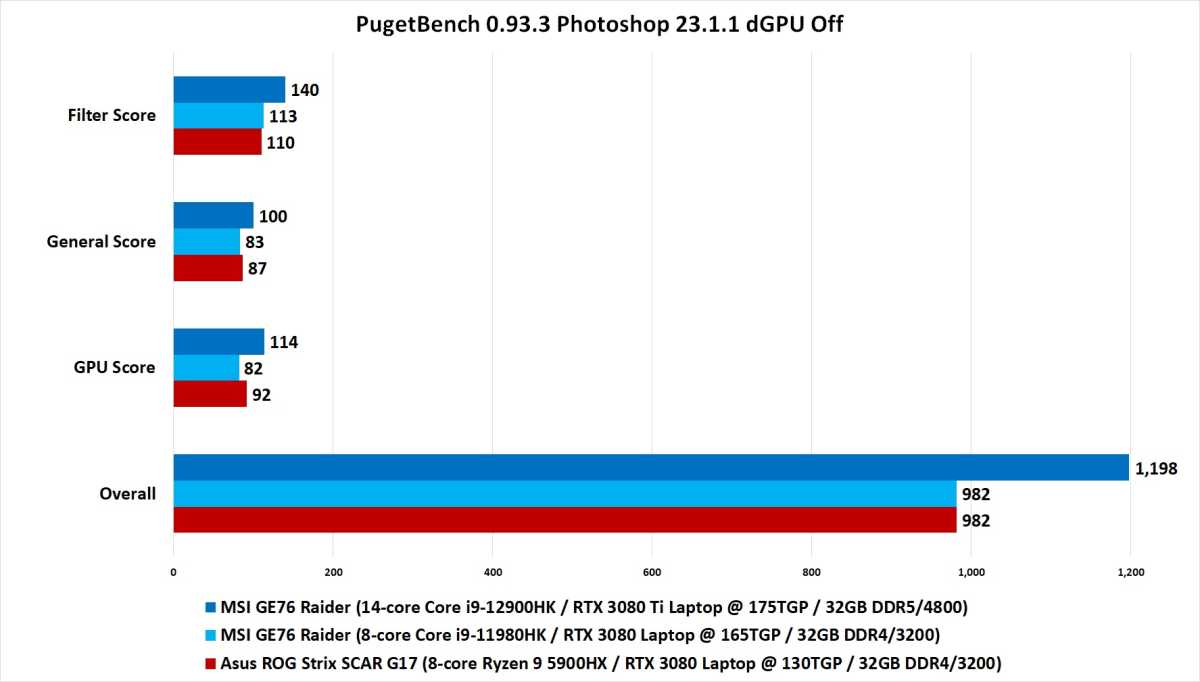
IDG
IDG
IDG
Photoshop tends to get all the glory but the unsung hero for working photographers is Adobe Lightroom Classic, which lets you quickly process the thousands of photos after a shoot. PugetBench has a test for Lightroom that breaks it down into Active Performance, where you are moving between modules and developing images, and a Passive Score that speaks to how long it takes to export images in bulk.
We also performed this test with the GeForce GPU on and off, but Lightroom Classic is less reliant on GPU performance so the results are nearly the same. That means we’ll go with just the GPU active scores.
It’s a pretty solid win for the Core i9-12900HK again, with it outpacing Ryzen 9 by 32.2 percent overall and 9.4 percent in active performance. It really opens up a can of whup-ass in the passive score with a batch export. The batch exports tends to favor more cores and Core i9-12900HK eats the Ryzen 9 5900HX up to the tune of 56.7 percent.
The older 11th-gen Core i9 also loses but not quite as badly, with the 12th gen Core i9 11.4 percent faster overall, basically dead even in the active score at 1.9 percent, and the passive score ahead by 19.5 percent.
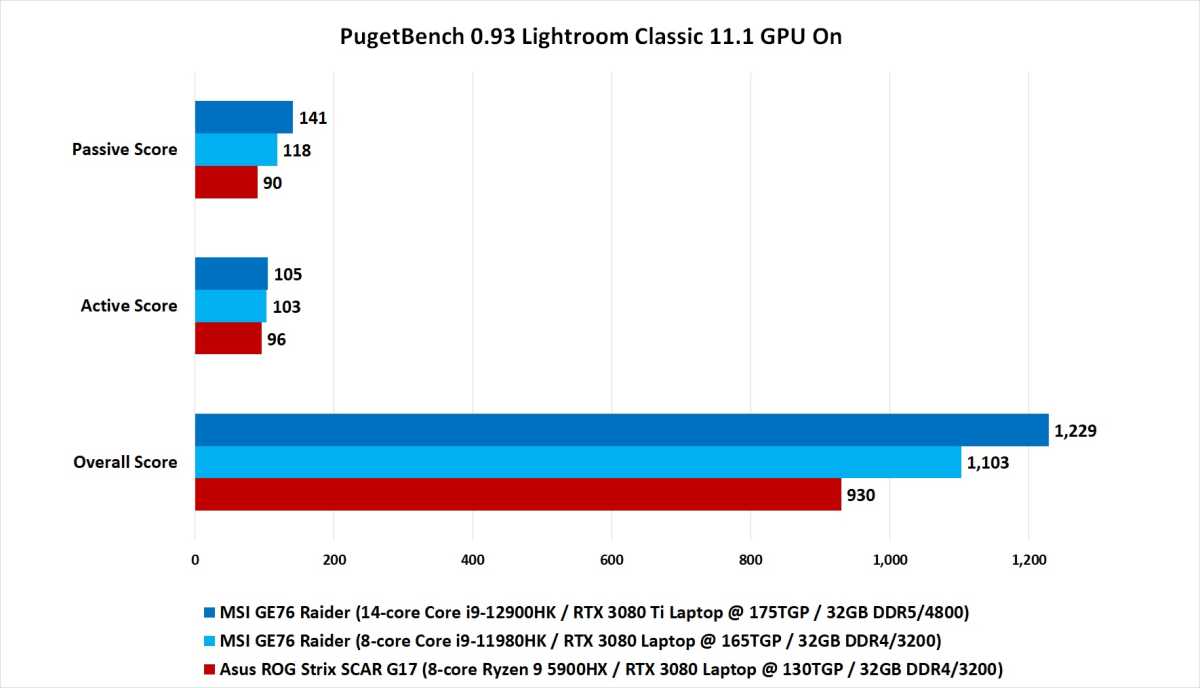
IDG
IDG
IDG
We said Adobe Photoshop and Lightroom Classic are important and we mean it. One problem with such huge suites is that performance depends very much on what you’re doing. For our second option, we use UL Procyon’s Photo Editing benchmark. Like PugetBench, it scripts Photoshop and Lightroom Classic with various tasks to give you a performance score.
But unlike PugetBench, the GPU has a little more sway in moving the numbers in Procyon, so we run it with the GeForce GPUs both on and off. With the GeForce 3080’s enabled, the Core i9-12900HK outpaces the Ryzen 9 by 16 percent overall and is pretty much dead even in Image Retouch actions. But it crushes the Ryzen 9 in the batch processing score. The 11th-gen Core i9 actually fares better, with the 12th-gen chip only beating it by 6 percent overall, again dead even in Image Retouch, and beating the older Intel CPU by 12 percent in the batch processing work.
With the discrete GPUs turned off it gets closer, with the Core i9-12900HK beating the Ryzen 9 by 9 percent overall, slightly slower or basically dead even with the AMD CPU in the image retouch portion, and beating team red by nearly 22 percent in batch processing. The 11th-gen laptop again does worse with its discrete GPU turned off and loses by 15 percent overall, 12 percent in image retouch, and 18.6 percent in the batch processing. The upshot is the 12th-gen wins, but it’s a closer contest than PugetBench.

IDG
IDG
IDG
Of all these applications, Premiere Pro typically gets the biggest boost from a GPU, so we again run PugetBench for Premiere Pro with the discrete GPU on and off. Between the 12th-gen Core i9 and the GeForce RTX 3080 Ti Laptop GPU, it’s a slaughter against the lower core-count CPUs and somewhat less powerful GPUs. The Core i9-12900HK comes out 62 percent head overall against the Ryzen 9. That breaks down to 26 percent for the video export, a massive 133 percent for the Live Playback score, 15.6 percent for the Effects Score, and 10 percent for the GPU score.
The 11th-gen Core i9 fares better, losing to the 12th-gen CPU by 34 percent overall, 26 percent for the export, and “only” 46 percent for the Live Playback score. It’s also 17.5 percent slower in the Effects Score and 15 percent slower in the GPU score.
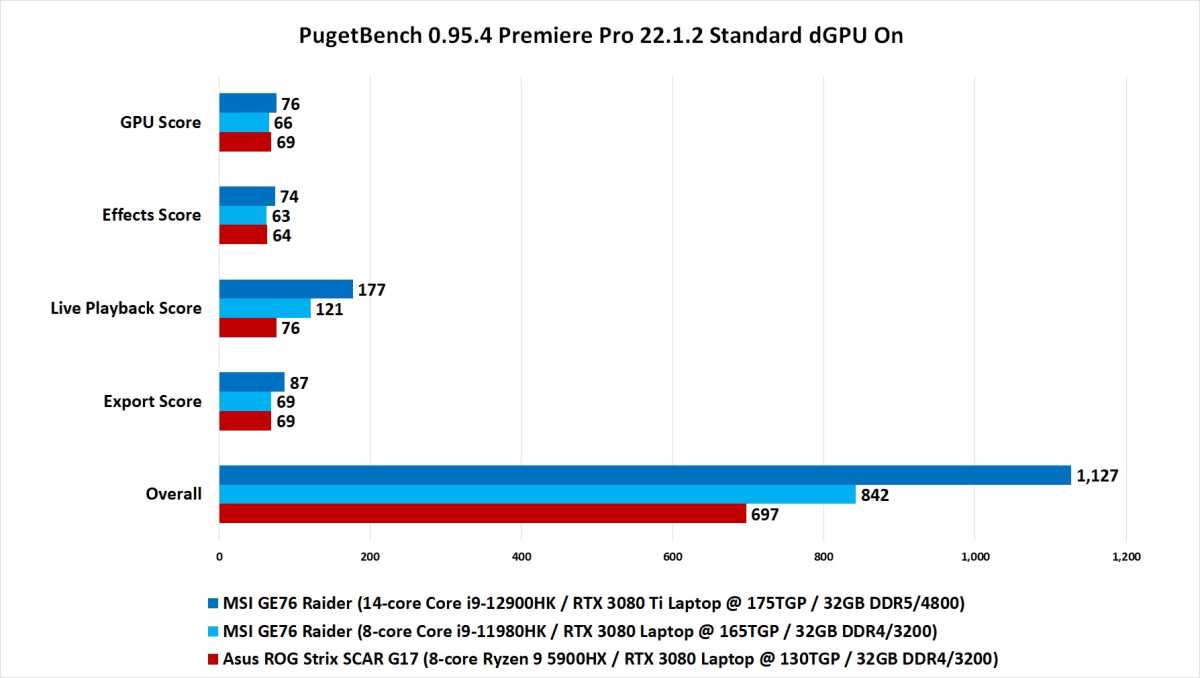
IDG
IDG
IDG
Yes, you’re saying this really isn’t fair. Unfortunately, there’s no way to equalize the GPUs between the laptops so we again just switch them off, which forces Premiere Pro to rely on the integrated graphics performance. Unfortunately for Ryzen 9 that doesn’t make it better, with the Core i9-12900HK now crushing it by 103 percent overall. That works out to 58 percent for the Export Score, 270 percent for the Live Playback Score, 33 percent for the Effects score, and 50 percent for the GPU score.
We know from our testing that AMD’s integrated Radeon graphics is a decent GPU, but when it comes to Adobe (as Apple can tell you), optimization is everything. It’s clear that in Premiere, having an Intel CPU’s Iris Xe graphics is going to net you better performance than AMD’s integrated Radeon graphics. Of course, that means you need a better Intel IGP. You don’t see a score for the 11th-gen Tiger Lake H laptop because Premiere Pro simply hung up and failed to complete the run.
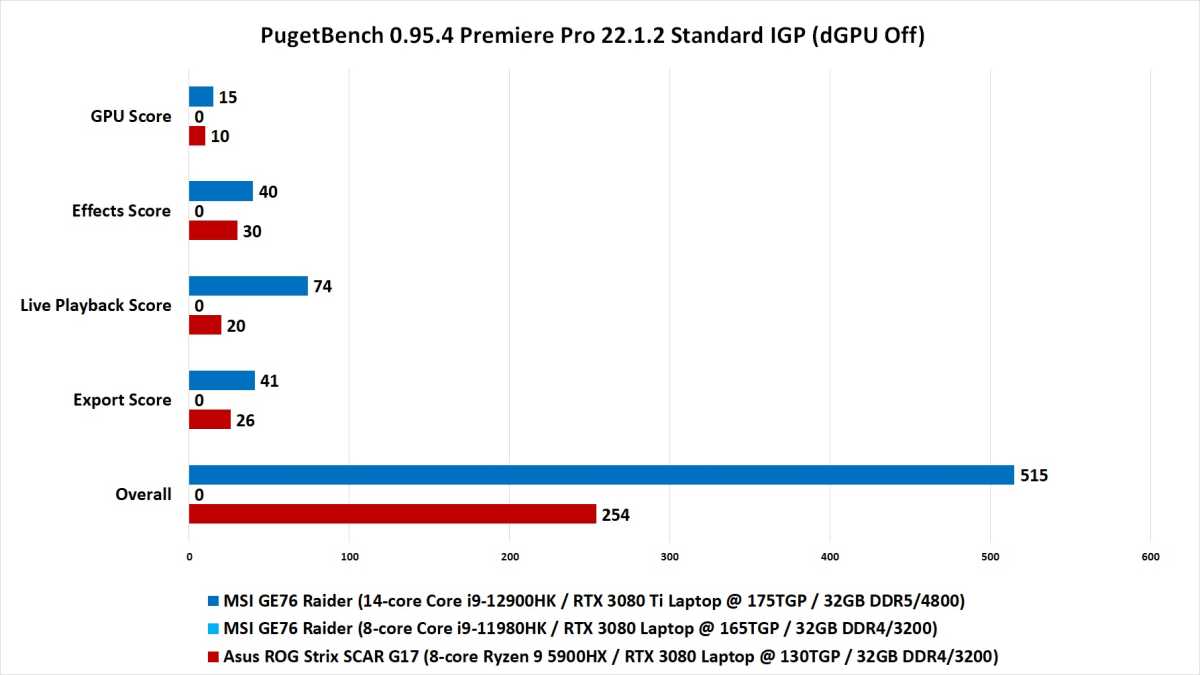
IDG
IDG
IDG
Our last result for the Adobe suite comes from UL’s Procyon Video Benchmark, which, like PugetBench, tasks Premiere with exporting several files while applying filters and other video adjustments. We’ll combine both the discrete on and off into the same chart but no matter how you cut it, the Core i9-12900HK wins.
With the discrete GPU on, the Core i9-12900HK comes in 28.6 percent faster than the Ryzen 9 and 12.4 percent faster than the 11th-gen Core i9. With the GeForced disabled, the 12th-gen Core i9’s Iris Xe helps it beat the Ryzen 9 by 42.2 percent. And, once again, the 11th-gen laptop fails to complete the run at all.
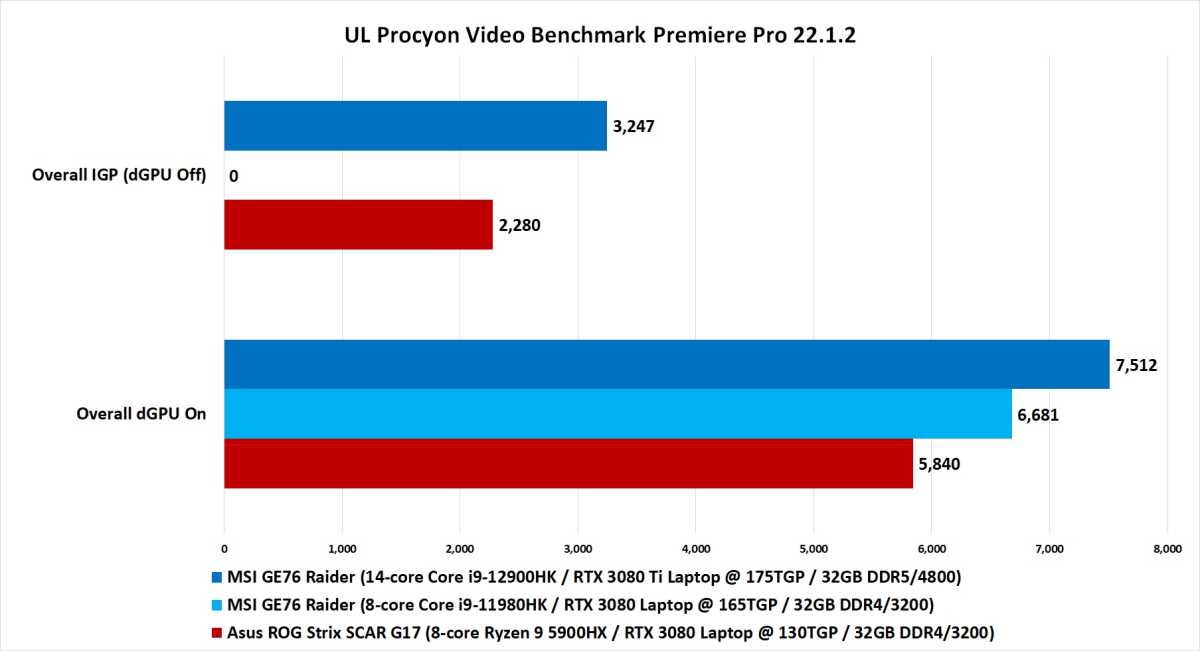
Higher scores are better. Right mouse click on image and select “open in new tab” to see original image.
Higher scores are better. Right mouse click on image and select “open in new tab” to see original image.
IDG
Higher scores are better. Right mouse click on image and select “open in new tab” to see original image.
IDG
IDG
Productivity performance
We all wished we sat around editing photos of our trip to Borneo or cutting videos for the last commercial we shot in Dubai, but the reality is 99 percent of the globe sits in front of Microsoft Office programs. If life has dealt you that hand, you might as well do it faster. For that, you’ll want a 12th-gen Core i9 over a Ryzen 9. The Core i9-12900HK outpaces the Ryzen 9 by 11.6 percent and the 11th gen by 6.7 percent using UL Procyon’s Office test.
Looking at the sub scores, PowerPoint is unimpressive. Word, however, is about 9 percent faster with the Core i9-12900HK. Excel gives the additional cores of the 12th-gen chip a nice 19 percent boost over Ryzen 9 and 16.9 percent over the 11th gen. The last surprise is Outlook, which appears to let you delete junk mail faster by about 19 percent over the Ryzen 9 and 10 percent over the 11th-gen Core i9.
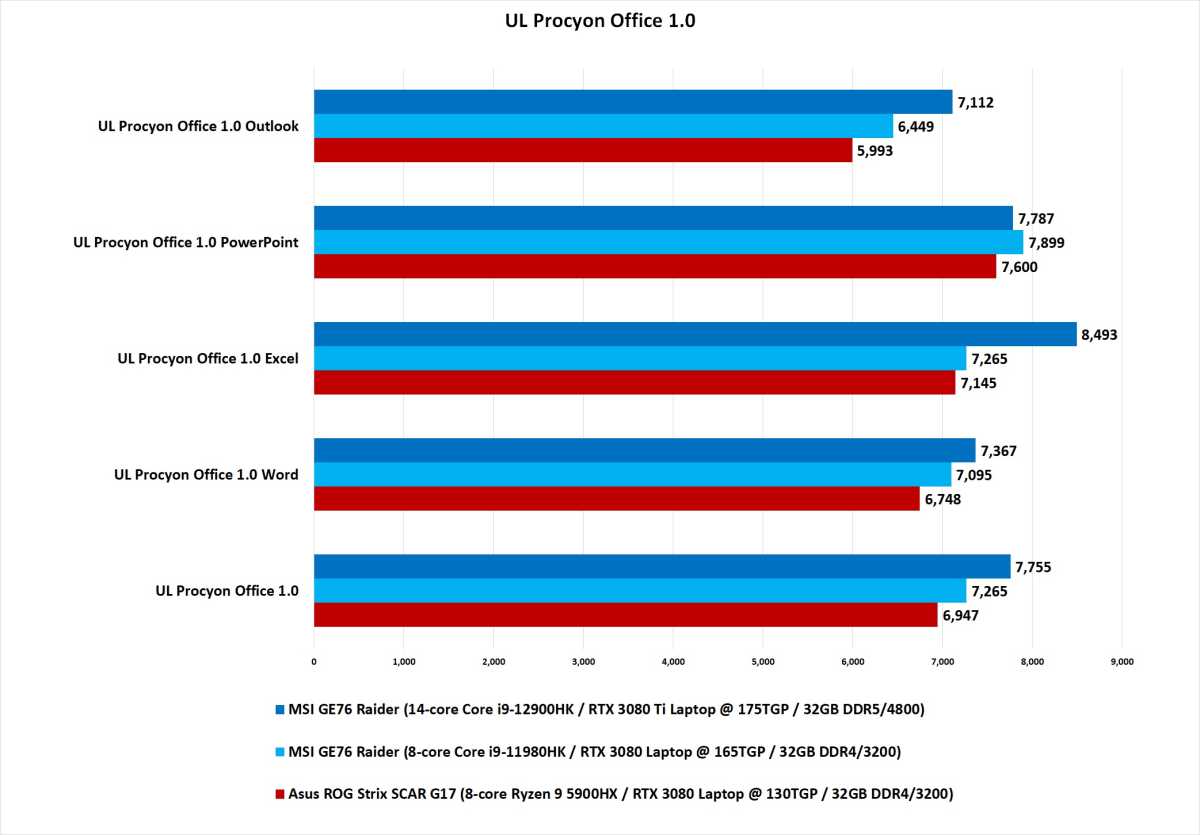
IDG
IDG
IDG
Esports Excel performance
If you’re a practical parent, you’re likely encouraging your child to be a professional video game player—at least not until after graduating from Harvard or Stanford with a law or medical degree. The one thing a pro-esport parent should never steer their kid clear of is Excel. Yes, Microsoft Excel is an esport now with the recent Financial Modeling World Cup held in December. It was even streamed to YouTube and ESPN. We’re not joking, it’s real and it was surprisingly fun to watch.
When the tournament was over, we realized we’ve underestimated just how powerful a tool Excel is. That’s why we decided to ask one of the participants in the FMWC, Jason Moore, to gin up a real-world Excel benchmark that could push today’s laptops to their limit. Moore, who works as an analyst at a New York hedge fund, provided us with a workbook he created in March of 2020 that tries to identify local flares ups of COVID 19.
The workbook is a practical, real-world use of Excel. It was used to identify impacts the pandemic would have on Las Vegas casinos, theme parks, cruise ships, and conferences. That practical intelligence could help predict, well, smart investments. Moore said the original version was linked to an AWS-hosted MySQL database that was refreshed nightly from dozens of websites such as OpenTable, NYC MTA, Google Mobility, and the like. It uses functions such as AVERAGEIFS, SUMPRODUCT, RANK, INDEX-MATCH, “and even old school ‘ctrl-shift’ arrays to find weighted averages based on multiple parameters,” Moore told PCWorld.
The full spreadsheet includes 17 million cells, with many hard coded from AWS with roughly half as formulas. For the laptop version, it’s scaled back to about 20 percent of the original. The full version takes more than hour to run on a Ryzen 9 5950X so we’ll keep it exclusive to high-end desktop chips. Properly written Excel workbooks can scale to 1,024 threads and we’ve seen this particular workbook scale to 36 threads—maxing out the the highest core-count PC we had on hand.
So, this is about as real as you can get for an intensive Excel task. It’s made by someone who drives Excel for a living and is an actual Excel esports player. How damned cool is that?
For our testing, we used the latest version of Microsoft Excel 2112 (Build 14729.20260) to run the workbook on. Since Excel stresses the core count when pushed to the limit with properly coded workbooks, the big winner was the Core i9-12900HK, which simply crushes the Ryzen 9 5900HX by 51 percent. Surprisingly, the 11th-gen Core i9 actually completes the test faster than the Ryzen 9 5900HX as well. We didn’t expect that as most of the thread-heavy tasks have put the Ryzen 9 on par or generally ahead of the 11th gen Core i9 at times. Clearly Excel is better optimized for Intel’s CPUs. That doesn’t help the 11th-gen against the 12th-gen chip though, which wins by an equally crushing 45 percent. That’s pretty fast. (In fact, the Core i9-12900HK is actually a bit faster than the $2,000, 18-core Core i9-7980XE we also ran this test on over on the desktop side.)
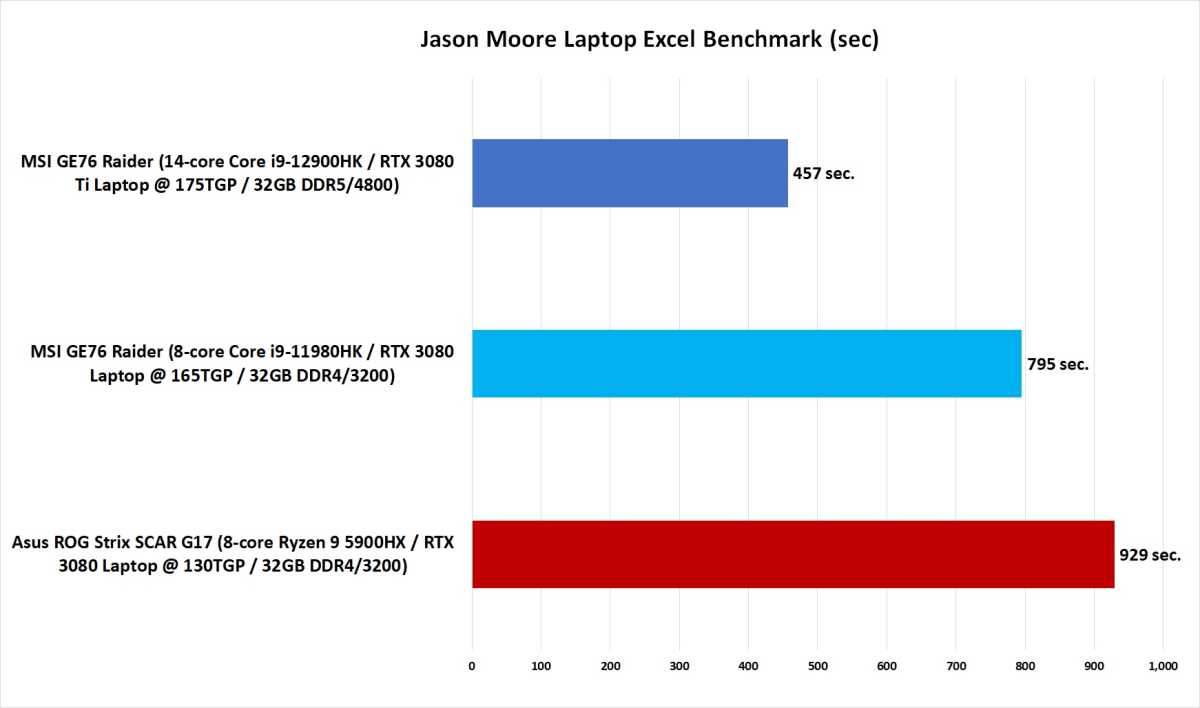
Lower times are better. Right mouse click on image and select “open in new tab” to see original image.
Lower times are better. Right mouse click on image and select “open in new tab” to see original image.
IDG
Lower times are better. Right mouse click on image and select “open in new tab” to see original image.
IDG
IDG
Browsing performance
There’s one universal application everyone uses and that’s an Internet browser. So, we took a look at the browser performance of each laptop using Edge (which utilizes the Chromium 97 engine) and several popular benchmarks. Browsing is largely a lightweight task, so we didn’t expect much but we actually saw some shocking results.
WebXprt 3 is a benchmark that tries to gauge browser performance in several tasks, such as photo editing, photo recognition, “homework,” OCR, and encryption using HTML5 and Javascript. The winner is the Core i9-12900HK by a decent, but not jaw-dropping 12.5 percent over the Ryzen 9, and 10 percent over the 11th-gen Core i9.
We also used JetStream 2, which is a WebAssembly and Javascript benchmark. You can read more about what those test here, but we essentially use it to test a browser’s speed. The Core i9-12900HK turned in a surprising 23 percent bump over the Ryzen 9 and 18.5 percent over the 11th-gen Core i9. In MotionMark 1.1, which looks at the graphics performance of a browser, we again were surprised to see the Core i9-12900HK finish 32 percent faster than the Ryzen 9 5900HX, and 25 percent faster than the 11th gen CPU.
The biggest shock, though, came from Speedometer 2.0, which is designed to measure browser responsiveness. We saw the Core i9-12900HK with a score 84 percent faster than the Ryzen 9 5900HX and 75 percent faster than the Core i9-11980HK. Wow.

IDG
IDG
IDG
Encoding performance
Let’s move on to encoding performance. We used Handbrake 1.5.1 to convert the open-source 4K video Tears of Steel using the advanced HEVC/H.265 codec. Although there’s a big push to move to the royalty-free AV1 codec by companies who have to pay those royalties, HEVC is on track to displace the less efficient H.264 codec very soon because of the greater demand for 4K streamed content.
We actually converted our video using two CPU profiles. When we converted the file to 1080p, the Core i9-12900HK squeaked by the Ryzen 9 by 2 percent—basically a tie. The 12th-gen chip did beat its predecessor by 15 percent at least. We then moved up to 4K using HEVC and the same frame rate as the original source. There, the Core i9-12900HK beat the Ryzen by 7.8 percent in encoding time, and the 11th-gen CPU by 20 percent. Those are decent victories, but not as crushing as we’ve seen elsewhere.
Since all of the laptops feature dedicated hardware for encoding, we had Handbrake use Intel’s Quick Sync and AMD’s VCE for the conversions as well. That resulted in a big win for the Core i9-12900HK with an encode taking 84.5 percent less time than it did on the Ryzen laptop. And although the 11th-gen laptop also has Quick Sync, the 12th-gen “Alder Lake H” CPU still wins by 34 percent.
Our final test tasked Handbrake with using the Nvidia encoder in the GPUs to do some heavy lifting. Surprisingly, the Quick Sync performance was better than the NVENC—but we should point out getting the encode settings to be exactly the same is problematic.
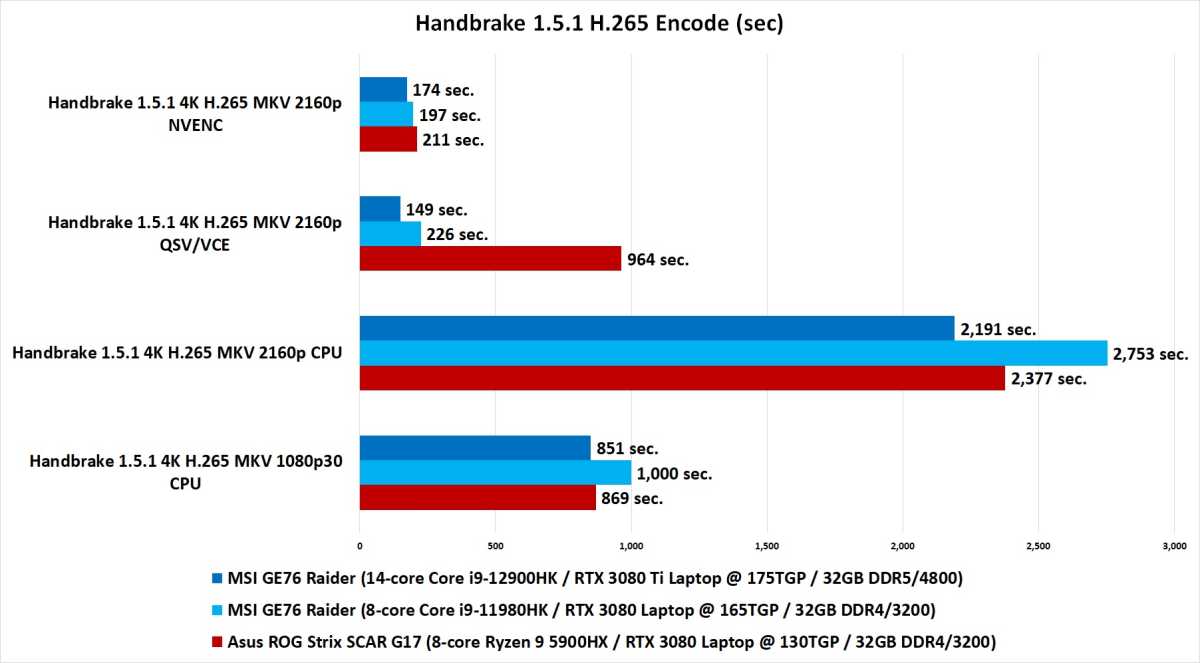
IDG
IDG
IDG
We don’t always run Primate Lab’s GeekBench 5 because it’s often used as a cudgel by hardware partisans rather than having serious discussions. Still, it’s a valuable benchmark to have official results for. The winner? The Core i9-12900HK, to the tune of 54 percent over the Ryzen 9 and 50 percent over the 11th Core i9 in the multi-core test. Single-core performance is equally impressive, with GeekBench giving the Core i9-12900HK a 20 percent advantage over the Ryzen 9 and a 13 percent bump over the 11th-gen Core i9.

IDG
IDG
IDG
Gaming performance
Gaming performance comparisons based on these laptops can’t be made, as it’s simply unfair with the Core i9-12900HK laptop having a huge advantage over the other two thanks to its faster GeForce RTX 3080 Ti GPU.
There are still a few things that can be gleaned about the CPU and the GPU, though. First up is UL’s popular 3DMark Time Spy test. It has a built-in test that examines CPU performance using real-world physics engines. In that test, we see the Core i9-12900HK with a 26 percent advantage over the Ryzen 9 and a 27 percent advantage over the 11th-gen laptop.
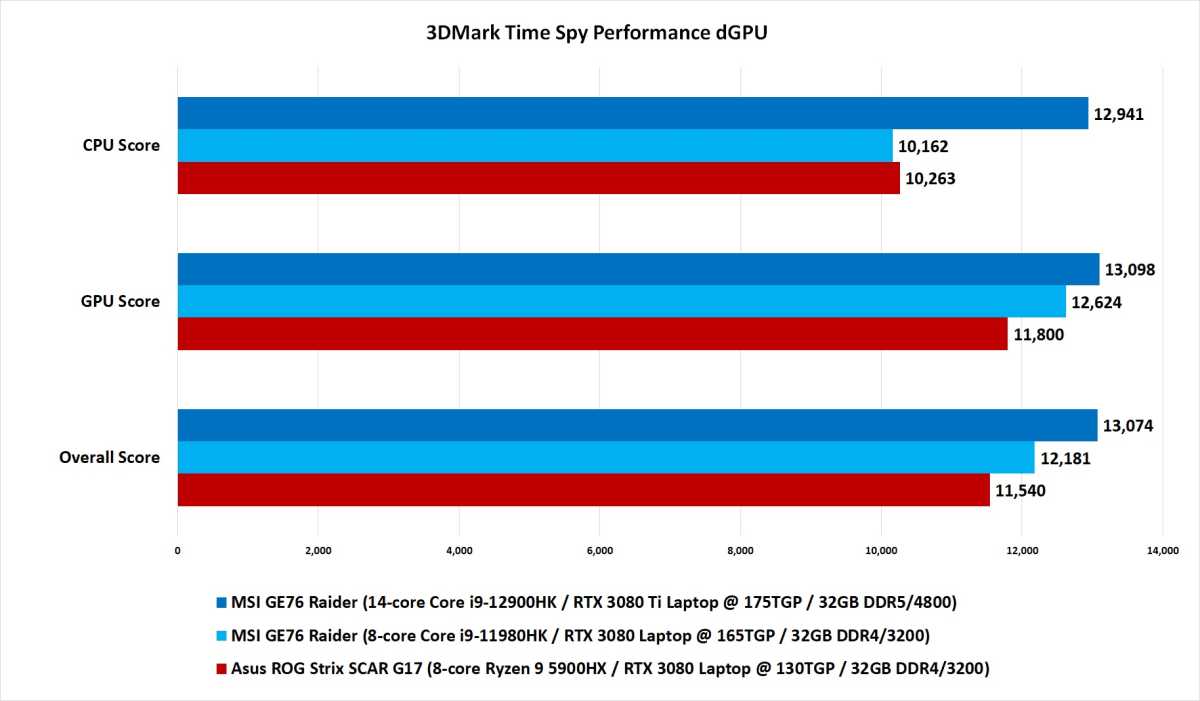
Higher scores are better. Right mouse click and select “open in new tab” to see original image.
Higher scores are better. Right mouse click and select “open in new tab” to see original image.
IDG
Higher scores are better. Right mouse click and select “open in new tab” to see original image.
IDG
IDG
For our actual gaming tests, we stuck with 1080p resolution since, well, all three laptops feature 1080p screens with 360Hz refresh rates. Again, it’s really difficult to try to isolate differences, but we can definitely say the Core i9-12900HK, when paired with the GeForce RTX 3080 Ti Laptop GPU, can outrun some of the fastest laptops made with previous generation parts. That’s obviously no surprise. We think, frankly, that if we wanted to see the GeForce RTX 3080 Ti Laptop GPU really stretch its legs, we’d need to run it on a 1440p resolution screen or higher.
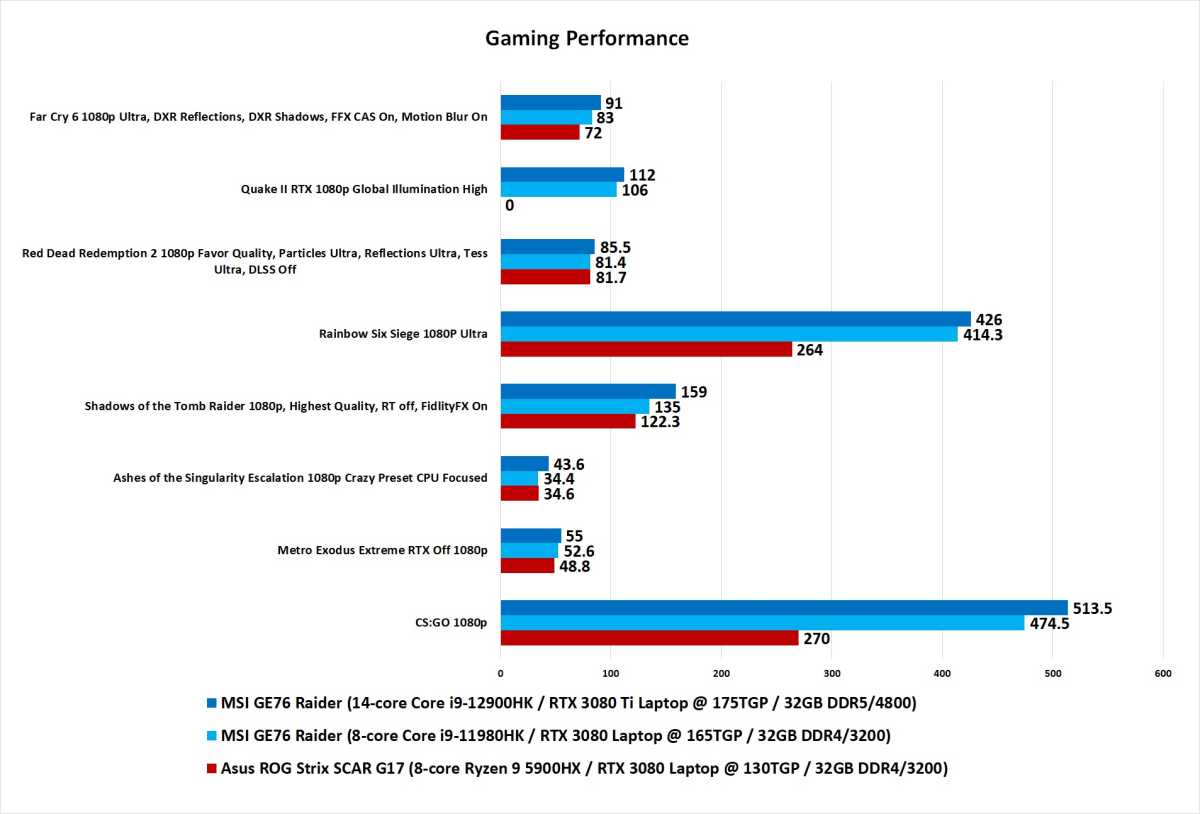
IDG
IDG
IDG
To try to get a bead on just how much the GeForce RTX 3080 Ti Laptop pays dividends, we also ran 3DMark’s DirectX Ray tracing benchmark, which is designed to gauge “pure ray tracing” performance using Microsoft’s DXR API. With a 20 percent increase in RT cores for the RTX 3080 Ti, we saw a pretty decent 22.3 percent increase over the GeForce RTX 3080 in the 11th-gen laptop and a 16 percent lead over the configuration in the Ryzen 9 laptop. That’s very respectable.
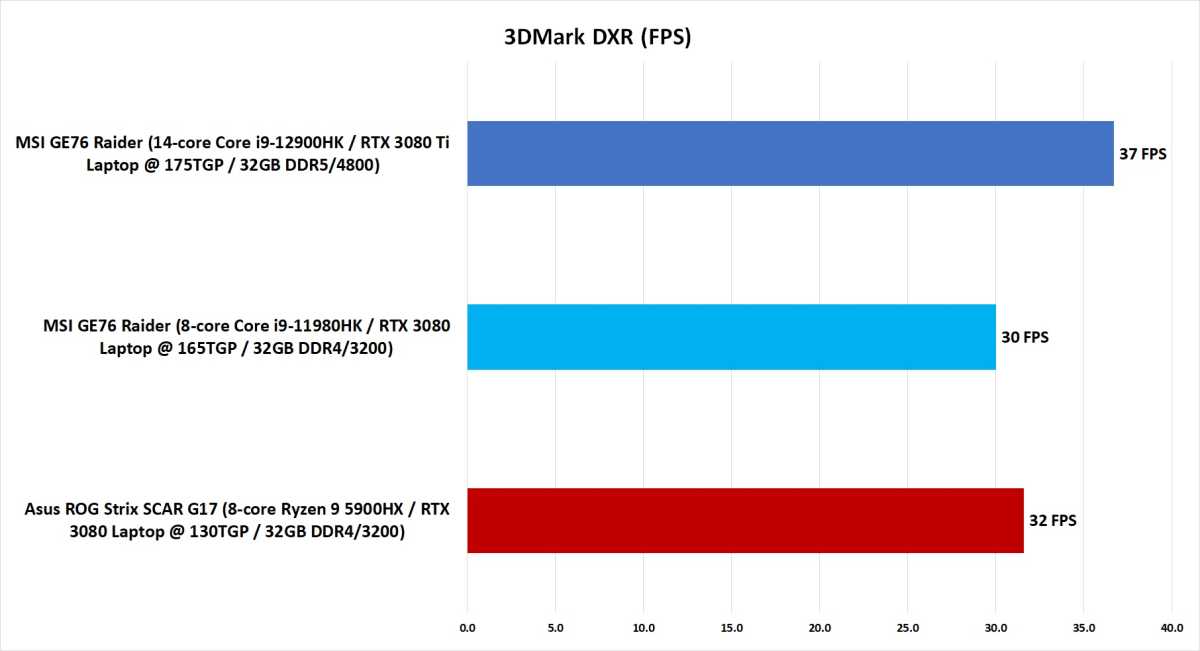
IDG
IDG
IDG
We also ran Time Spy with the graphics integrated on each CPU, and the Iris Xe graphics in the Core i9-12900HK provide a pretty decent 36.6 percent advantage over the Ryzen 9. Much if not most that performance bump may come from the DDR5 in the 12th-gen laptop. As integrated graphics (IGP) relies on the system’s RAM, the more bandwidth you can get in a laptop with an IGP, the better the performance. The Core i9-12900HK laptop also crushes the older 11th-gen CPU thanks to its more limited GPU execution units. When Intel rolled out the 11th-gen laptop chips, the company said it didn’t make sense to use the space for the IGP since these CPUs would be paired with a GPU anyway. Why that’s different with 12th-gen, we’re not sure, but it’s clearly a lot more performance.
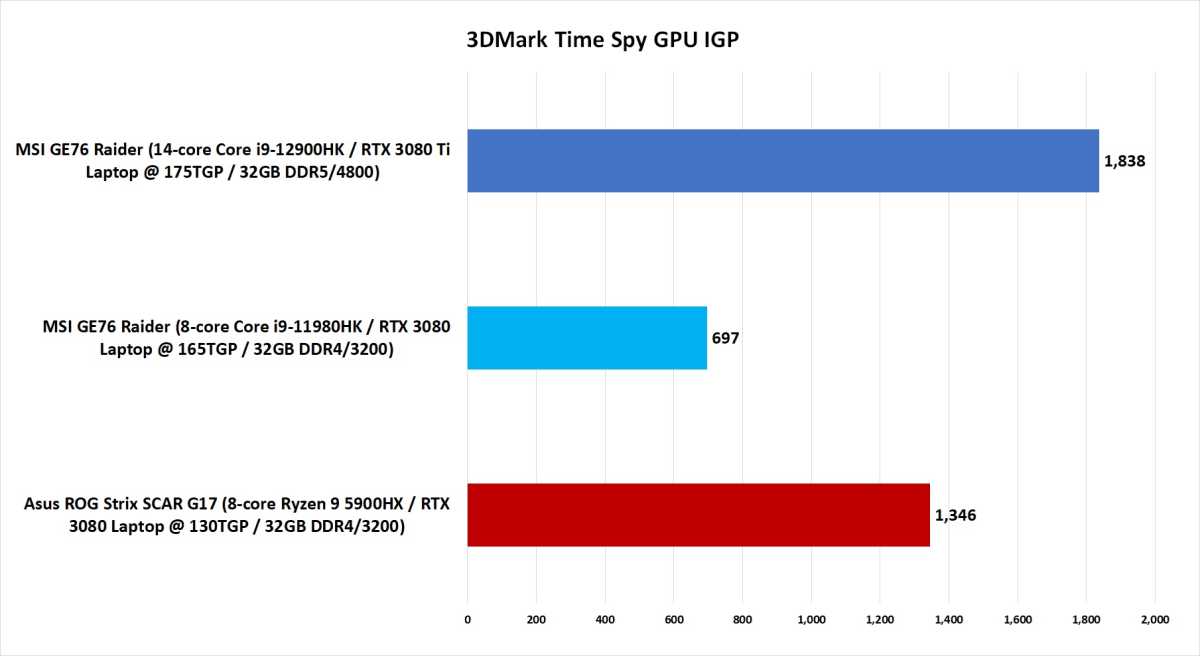
IDG
IDG
IDG
Our last 3DMark result is for people who wonder just how much of a difference it made by cutting the Core i9-12900HK’s GPU interface down to 8 PCIe 4.0 lanes, rather than the 16 lanes found in the 11th-gen Core i9. The answer is a lot. In fact, the Core i9-12900HK offers basically the same PCIe bandwidth as an older 10th-gen laptop with 16 lanes of PCIe 3.0. But since this particular GPU uses the faster PCIe 4.0, the bandwidth between the two is similar. Obviously, the Core i9-12900HK’s 8 lanes doesn’t provide the crazy amounts of bandwidth a full 16 lanes of PCIe 4.0 gives you, but most (if not all) games simply don’t need it.
So why make this change? Intel is likely saving power and using those lanes elsewhere in the system. It’s also probably looking to the future when PCIe 5.0 GPUs arrive, which would give 8 lanes of PCIe the same bandwidth as the 11th-gen chip got with a full 16 PCIe 4.0 lanes. Of course, Intel can also say it’s not so limited. If you want limited, look at the Ryzen 9 5900HX, with its eight lanes of PCIe 3.0.
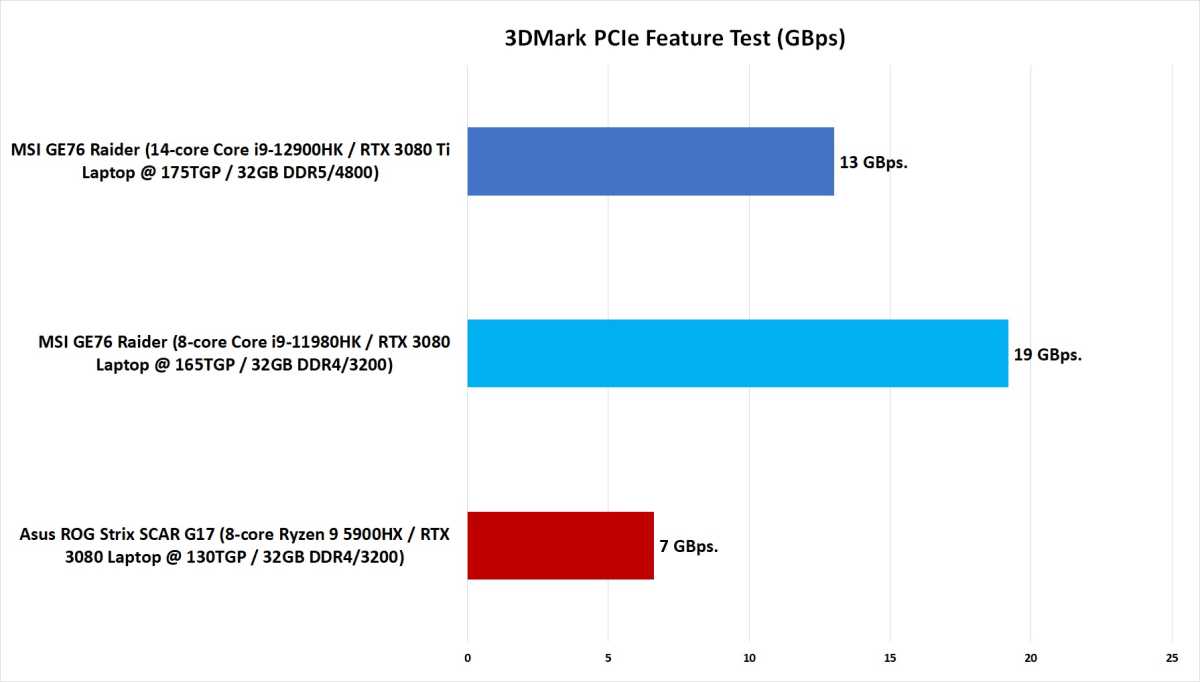
Higher scores are better. Right mouse click on image and select “open in new tab” to see original image.
Higher scores are better. Right mouse click on image and select “open in new tab” to see original image.
IDG
Higher scores are better. Right mouse click on image and select “open in new tab” to see original image.
IDG
IDG
Power efficiency
It’s pretty difficult to gauge power efficiency of a laptop’s CPU without considering that the entire laptop contributes to how much power it uses. Still, we did want to get a glimpse of how much power the Core i9-12900HK laptop uses under a heavy load, so we charged the laptop’s batteries to 100 percent, turned off all of the LEDs, and set the three laptop screens to the same brightness. With the batteries full, the power the laptops consume ideally would give us an idea of how much power the CPUs, RAM, and associated hardware are drawing from their power bricks.
We then simultaneously measured the power each drew from the wall while running the CPU-only Cinebench R23 test. Under an all-core load you can see the 12th-gen Core i9 spike up to 140 watts, but it soon drops with power consumption actually below that of the Ryzen 9 and 11th-gen Core i9. What’s also quite interesting about the results are the power sags as Cinebench resets each scene after it’s rendered. Cinebench R23 runs for 10 minutes and continues past that if the CPU is still rendering a scene. We can see the purple line dropping first, which means the Core i9-12900HK finished the test first. We can also count the sags and see that the 12th-gen Core i9 rendered 12 scenes in less time than the Ryzen 9, which completed 10 renders. The 11th-gen Core i9 itself only renders nine.
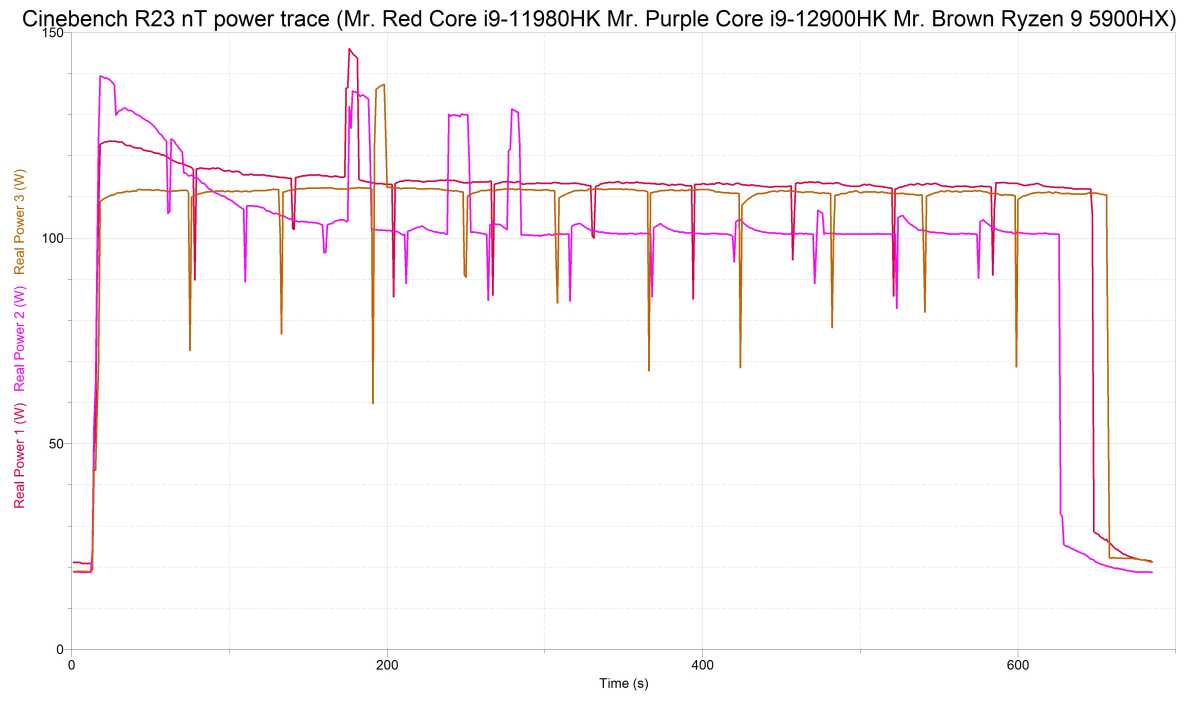
IDG
IDG
IDG
When it comes to Cinebench R23, using all cores is a pretty hefty load, so we also wanted to peak at power consumed while running a very light load. That’s why we recorded the laptops while running Speedometer 2.0 in Edge. It’s a very light task and you can see Intel’s 12th-gen and 11th-gen CPUs pushing just under 60 watts, while the Ryzen 9 is under 50 watts. This test also gives you a hint as to how insanely fast the Core i9-12900HK is in this particular browser test. It completes Speedometer 2.0’s 10 loops in just over a third of the time it takes the Ryzen 9 and 11th gen to finish. Again: Wow.
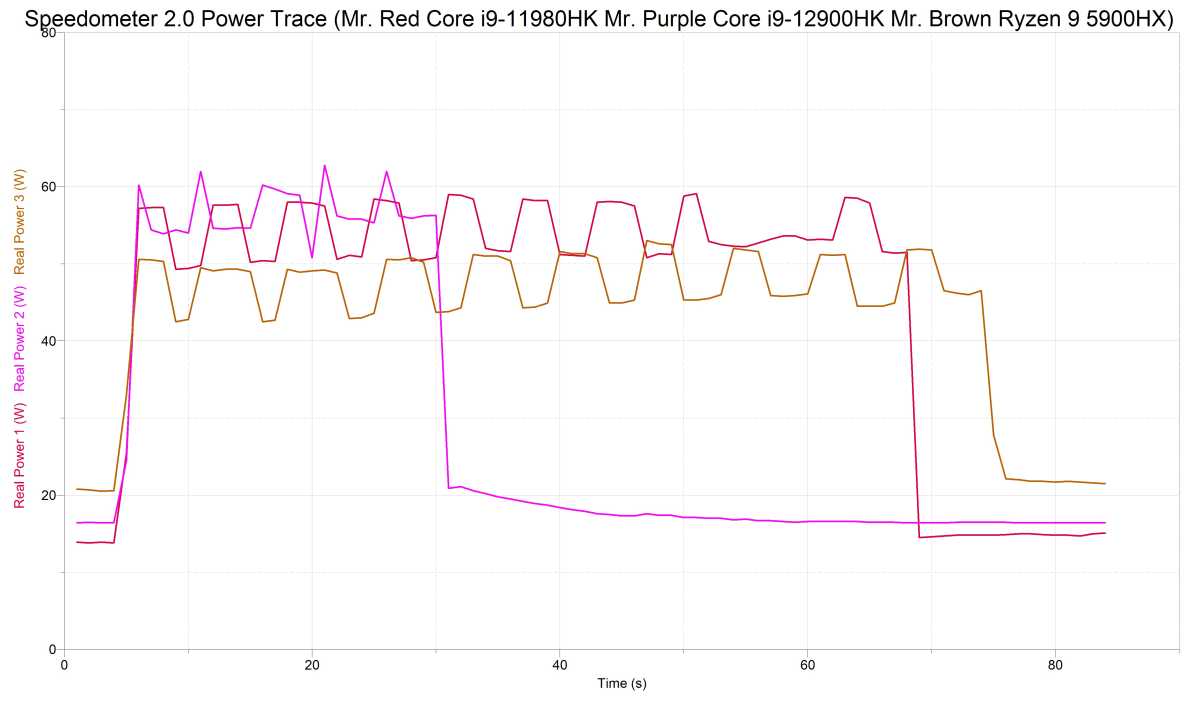
Right mouse click on image and select “open in new tab” to see original image.
Right mouse click on image and select “open in new tab” to see original image.
IDG
Right mouse click on image and select “open in new tab” to see original image.
IDG
IDG
But yes, you want to know about battery life, so we’ll indulge you by running our standard battery rundown test, which sets the screen brightness to 250 to 260 nits and puts the laptop itself in airplane mode while looping a 4K video. We set the laptops to their balanced settings and switched off all LEDs. We do want to mention the 12th-gen laptop has two SSDs, but in theory, the second SSD should use very little power unless it’s actively being accessed. We also pulled a brain lock by leaving a USB SSD plugged into the 11th gen laptop during its rundown. Besides an external M.2 NVMe SSD, the drive also features RGB lighting, which may materially impact its run time. We’re rerunning the test and will update our results once have them.
Overall, the Core i9-12900HK doesn’t do too badly with nearly 6 hours of offline video playback. Certainly, the Ryzen 9 does better at over six hours. And that’s with a battery that’s about 10 percent smaller than the 12th-gen system.
We’ll conduct more in-depth battery and performance while on battery tests in the months to come, but it looks like the Core i9-12900HK is at least competitive. Any laptop you fire up with a 175-watt GPU with a 45+ watt CPU will deliver pretty mediocre battery life at best, no matter what.
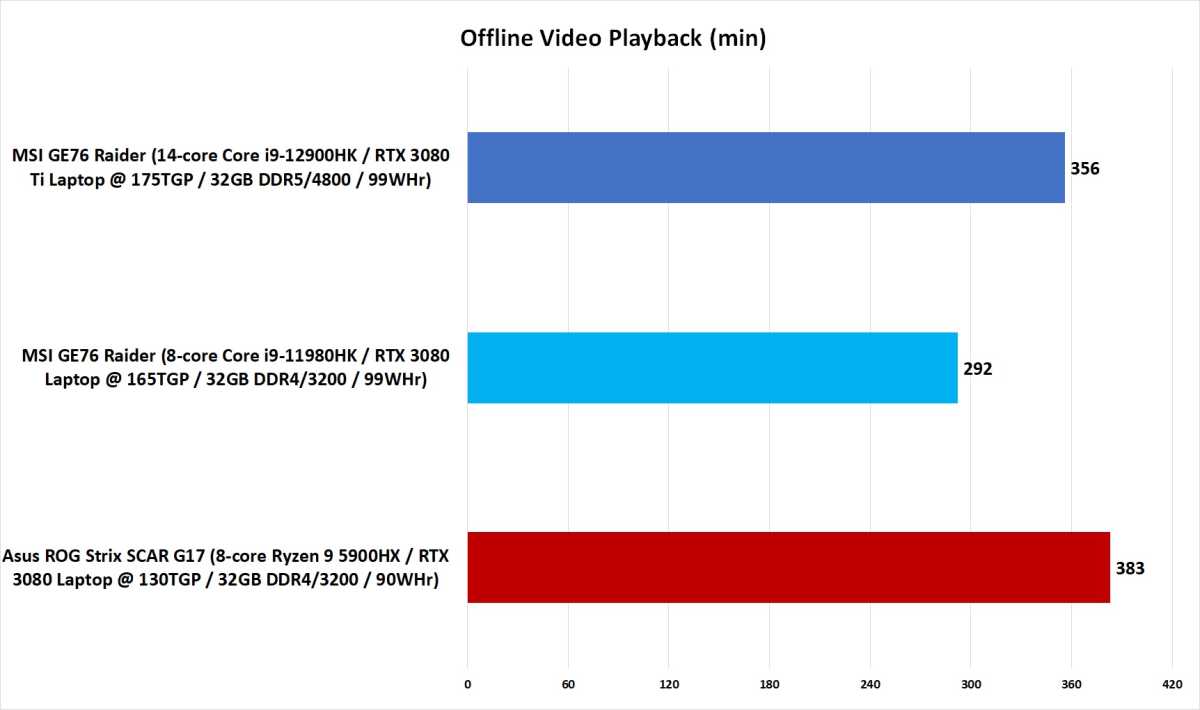
IDG
IDG
IDG
We’ll close our results with Cinebench R20, which we run using a single-thread all the way up to the maximum threads available in a processor. The idea is to get a general feel for what kind of performance you’ll get on lightly-threaded tasks as well as heavy-threaded ones. First, we’ll look at the Core i9-12900HK versus the 11th-gen Core i9. This is where we see a double-digit increase in performance, with a very decent 15 percent to 19 percent increase in lightly threaded tasks. And, mind you, the 11th-gen Core i9 is itself a very fast CPU, especially on lighter tasks. The Core i9-12900HK’s 14-cores—even if eight of them are efficiency cores—start to climb for the stars on the heavier chores. That’s 35 percent faster.
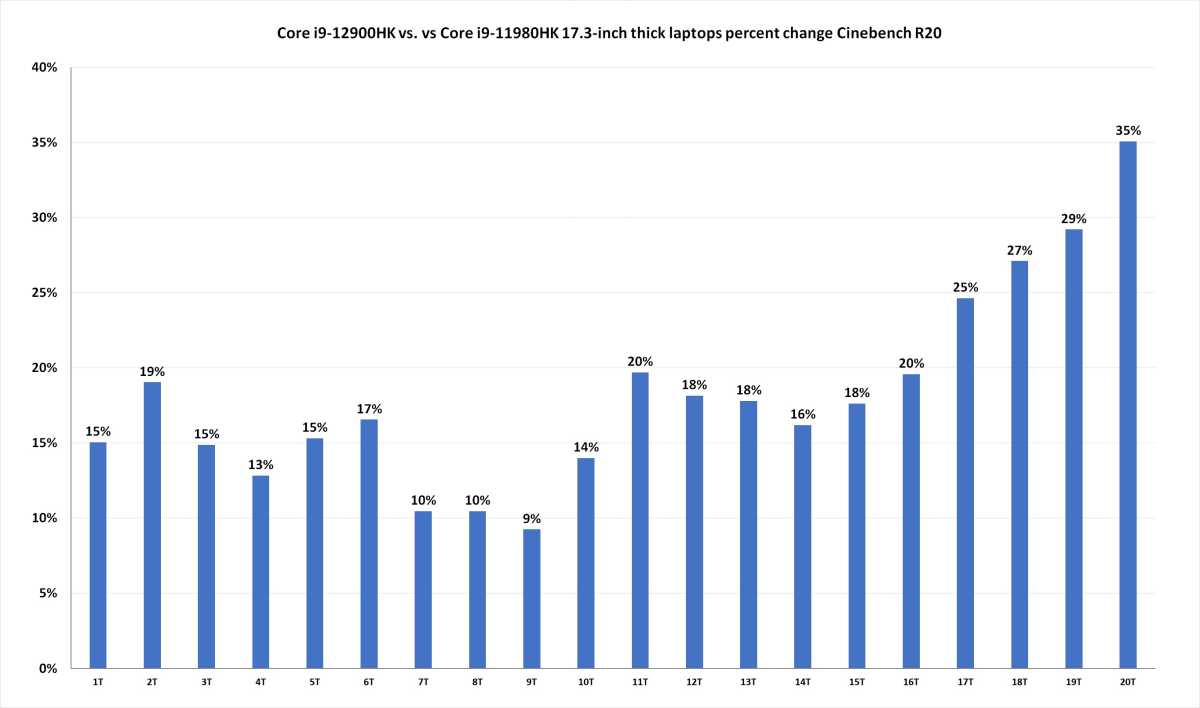
Right mouse click on image and select “open in new tab” to see original image.
Right mouse click on image and select “open in new tab” to see original image.
IDG
Right mouse click on image and select “open in new tab” to see original image.
IDG
IDG
Next, we see how the Core i9-12900HK performs against the Ryzen 9. The Ryzen 9 struggled with lighter tasks, so we see the 12th-gen open up an impressive 22 percent to 27 lead in that area. There’s a performance sag in the Core i9-12900HK once it’s beyond its six available performance cores, but its greater number of efficiency cores still manage to keep it ahead, and it ultimately ends up performing 22 percent faster in heavily threaded tasks.
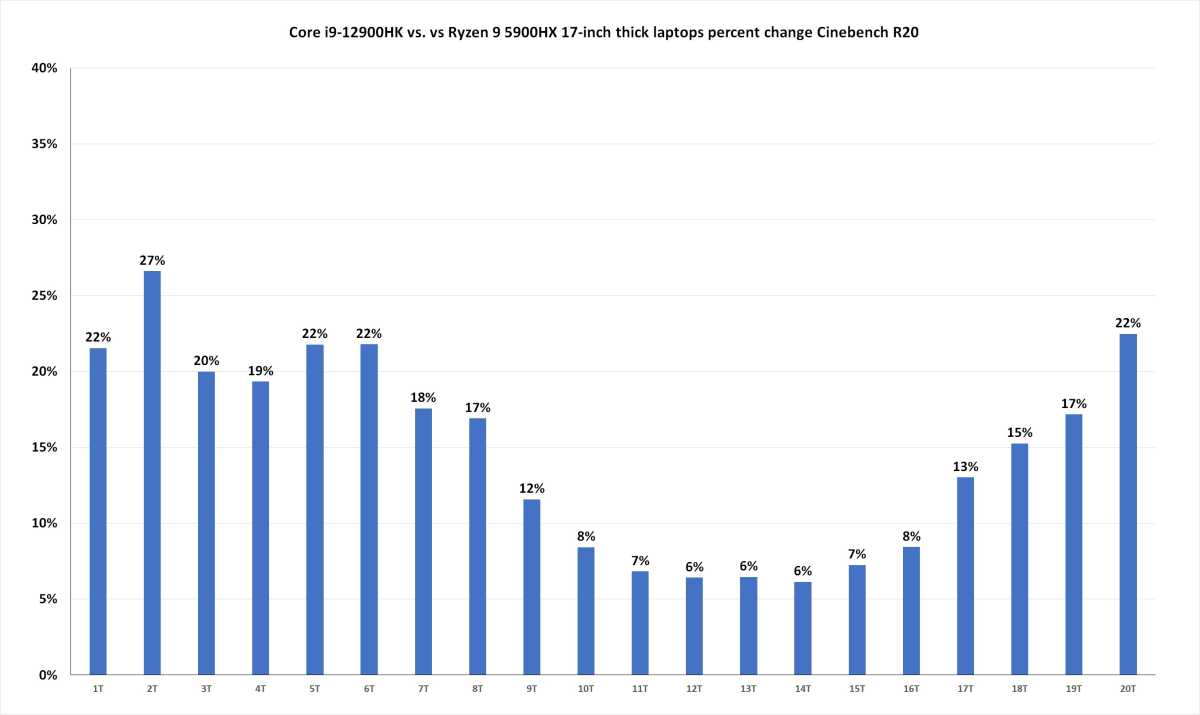
Right mouse click on image and select “open in new tab” to see original image.
Right mouse click on image and select “open in new tab” to see original image.
IDG
Right mouse click on image and select “open in new tab” to see original image.
IDG
IDG
Bottom line
It’s hard to believe that CPUs as fast and impressive as AMD’s Ryzen 9 5900HX and Intel’s 11th Core i9-11980HK get their lunches eaten almost across the board by the 12th-gen Core i9-12900HK, but that’s what you just witnessed. Sure, those older CPUs are still relevant and remain quite powerful in their own right, but compared to the 12th-gen “Alder Lake H” flagship—which does almost everything better—they’d be hard to recommend. It’s pretty clear: Intel’s Core i9-12900HK is the new high-performance laptop champion, and it’s not even close.

Intel
Intel
Intel
Author: Gordon Mah Ung, Executive Editor

One of founding fathers of hardcore tech reporting, Gordon has been covering PCs and components since 1998.
Recent stories by Gordon Mah Ung:
I’m not afraid of Qualcomm’s Snapdragon X ElitePC maker offers a potential fix for crashing Intel CPUsThe Full Nerd ep 248: Ryzen 9 7950X3D and the state of PC gaming






